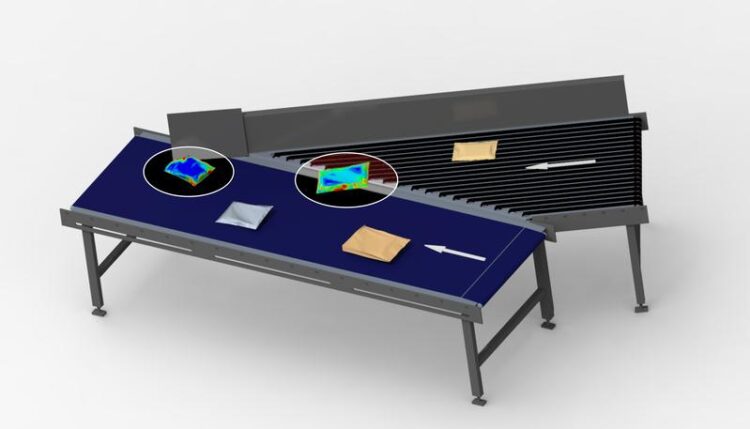Digital Twin for Flexible Parcel Postage

Tracking a mailing bag within the simulation.
(c) ITL - TU Graz
Non-rigid postal items with flexible packaging – such as poly bags – pose problems for logistics companies during automatic sorting. Thanks to modern simulation methods, there is now a widely applicable solution.
Anyone who orders something online would like to have the parcel delivered reliably, quickly and undamaged. The sharp rise in the number of different types of mailing bags and mailing sacks in recent years – postal items with flexible packaging and a limited degree of dimensional stability – has made it increasingly difficult for logistics service providers to offer this service. In contrast to solid cardboard packages, such bags and sacks change shape during transport and can therefore interfere with reliable automatic sorting. The Institute of Logistics Engineering at Graz University of Technology (TU Graz), Österreichische Post (Austrian Post) and Körber have tackled this problem in the ISAAK project, which is funded by the Austrian Research Promotion Agency (FFG). Using realistic physical simulations, they have developed a solution that can also be used outside of parcel postage.
Parcel volume requires automation
“The number of mailing bags has risen sharply in recent years, particularly for shipments from the Far East, due to the lower costs,” explains project manager Christian Landschützer from the Institute of Logistics Engineering at TU Graz. “To cope with the large volumes, logistics specialists sort the consignments automatically, and with the method we have developed, this can now be done more reliably with mailing bags than before. As far as we know, we are currently the only ones in the world to have tackled this issue.”
This method, which allows the behaviour of a mailing bag to be simulated with physical precision, makes it much easier to virtually track, recognise, physically describe and therefore sort a shipment on its journey through a logistics centre. A practical feature of the solution is that it can be applied to numerous other flexible packaging solutions with loose contents in the form of bulk or piece goods. And it is also fit for the future, as it can be used to simulate future changes in packaging materials.
Measuring during operation
The first step in developing the realistic simulation was to find out what types of parcels are on the move. To do this, the researchers had to measure numerous parcels and describe their characteristics – all this was carried out at an Austrian parcel sortation centre during operation, since they could not take the parcels away with them for examination. The research team grouped the different package types into classes – known as clusters – and set about recreating these classes.
Experiments were carried out with the replicas of these package types at Körber’s test facility on Lake Constance. The test results provided data for calibrating the parameters of the simulation model. This was created using modern multi-body-dynamics and mechanical-physical simulation methods that can precisely reproduce the real behaviour of a consignment. Of particular interest are the forces acting on the parcels, which were analysed. Logistics companies can now use the clusters and their realistic simulation to improve the recognition and processing of consignments in their sorting systems. Producers of conveyor technology, such as project partner Körber, are utilising the findings for the new and further development of sorting systems in a virtual environment.
Follow-up project on parcel interaction in progress
“Although the problem of flexible packaging comes from the postal sector, it was important for us to look at the topic from the perspective of basic research in order to find a solution for several areas of application. This means that a wide variety of sectors can benefit from our results,” says Christian Landschützer. The Institute of Logistics Engineering would now like to utilise the research results of the ISAAK project for a follow-up project already in preparation. Instead of just one, several mailing bags and their interaction with each other will then be simulated in order to further improve the description of consignments in the sorting process.
This research area is anchored in the Field of Expertise “Mobility & Production“, one of five strategic foci of TU Graz.
Wissenschaftliche Ansprechpartner:
Christian LANDSCHÜTZER
Assoc.Prof. Dipl.-Ing. Dr.techn. Prof.h.c.
TU Graz | Institute of Logistics Engineering
Phone: +43 316 873 7325
Mobile: +43 664 60 873 7325
landschuetzer@tugraz.at
Media Contact
All latest news from the category: Transportation and Logistics
This field deals with all spatial and time-related activities involved in bridging the gap between goods and people, including their restructuring. This begins with the supplier and follows each stage of the operational value chain to product delivery and concludes with product disposal and recycling.
innovations-report provides informative reports and articles on such topics as traffic telematics, toll collection, traffic management systems, route planning, high-speed rail (Transrapid), traffic infrastructures, air safety, transport technologies, transport logistics, production logistics and mobility.
Newest articles

Innovative 3D printed scaffolds offer new hope for bone healing
Researchers at the Institute for Bioengineering of Catalonia have developed novel 3D printed PLA-CaP scaffolds that promote blood vessel formation, ensuring better healing and regeneration of bone tissue. Bone is…

The surprising role of gut infection in Alzheimer’s disease
ASU- and Banner Alzheimer’s Institute-led study implicates link between a common virus and the disease, which travels from the gut to the brain and may be a target for antiviral…

Molecular gardening: New enzymes discovered for protein modification pruning
How deubiquitinases USP53 and USP54 cleave long polyubiquitin chains and how the former is linked to liver disease in children. Deubiquitinases (DUBs) are enzymes used by cells to trim protein…



